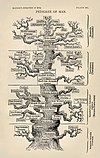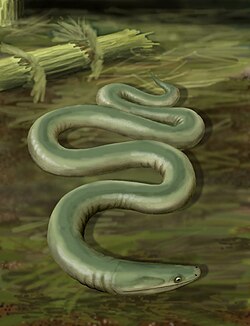User:Abyssal/Portal:Carboniferous
IntroductionThe Carboniferous (/ˌkɑːrbəˈnɪfərəs/ KAR-bə-NIF-ər-əs) is a geologic period and system of the Paleozoic that spans 60 million years from the end of the Devonian Period 358.9 Ma (million years ago) to the beginning of the Permian Period, 298.9 Ma. In North America, the Carboniferous is often treated as two separate geological periods, the earlier Mississippian and the later Pennsylvanian. The name Carboniferous means "coal-bearing", from the Latin carbō ("coal") and ferō ("bear, carry"), and refers to the many coal beds formed globally during that time. The first of the modern "system" names, it was coined by geologists William Conybeare and William Phillips in 1822, based on a study of the British rock succession. Carboniferous is the period during which both terrestrial animal and land plant life was well established. Stegocephalia (four-limbed vertebrates including true tetrapods), whose forerunners (tetrapodomorphs) had evolved from lobe-finned fish during the preceding Devonian period, became pentadactylous during the Carboniferous. The period is sometimes called the Age of Amphibians because of the diversification of early amphibians such as the temnospondyls, which became dominant land vertebrates, as well as the first appearance of amniotes including synapsids (the clade to which modern mammals belong) and sauropsids (which include modern reptiles and birds) during the late Carboniferous. Due to the raised atmospheric oxygen level, land arthropods such as arachnids (e.g. trigonotarbids and Pulmonoscorpius), myriapods (e.g. Arthropleura) and insects (e.g. Meganeura) also underwent a major evolutionary radiation during the late Carboniferous. Vast swaths of forests and swamps covered the land, which eventually became the coal beds characteristic of the Carboniferous stratigraphy evident today. The later half of the period experienced glaciations, low sea level, and mountain building as the continents collided to form Pangaea. A minor marine and terrestrial extinction event, the Carboniferous rainforest collapse, occurred at the end of the period, caused by climate change. (Full article...) Selected natural world article
Amphibians are ectothermic, tetrapod vertebrates of the class Amphibia (Greek ἀμφí, amphi, "both" + βíος, bios, "life"). They inhabit a wide variety of habitats with most species living within terrestrial, fossorial, arboreal or freshwater aquatic ecosystems. Amphibians typically start out as larvaliving in water, but some species have developed behavioural adaptations to bypass this. The young generally undergo metamorphosis from larva with gills to an adult air-breathing form with lungs.
The earliest amphibians evolved in the Devonian Period from sarcopterygian fish with lungs and bony-limbed fins, features that were helpful in adapting to dry land. They diversified and became dominant during the Carboniferous and Permian periods, but were later displaced by reptiles and other vertebrates. Over time, amphibians shrank in size and decreased in diversity, leaving only the modern subclass Lissamphibia. The three modern orders of amphibians are Anura (the frogs and toads), Caudata/Urodela (the salamanders), and Gymnophiona/Apoda (the caecilians). The total number of known amphibian species is approximately 7,000, of which nearly 90% are frogs. The largest living amphibian is the 1.8 m (5 ft 11 in) Chinese giant salamander (Andrias davidianus) but this is dwarfed by the extinct 9 m (30 ft) Prionosuchus from the middle Permian of Brazil. The study of amphibians is called batrachology, while the study of both reptiles and amphibians is called herpetology. (see more...) Did you know...
Need help?Do you have a question about Abyssal/Portal:Carboniferous that you can't find the answer to? Consider asking it at the Wikipedia reference desk. Selected image
Selected science, culture, or economics article In 1858, Charles Darwin and Alfred Russel Wallace published a new evolutionary theory that was explained in detail in Darwin's On the Origin of Species (1859). Unlike Lamarck, Darwin proposedcommon descent and a branching tree of life. The theory was based on the idea of natural selection, and it synthesized a broad range of evidence from animal husbandry, biogeography, geology, morphology, and embryology. The debate over Darwin's work led to the rapid acceptance of the general concept of evolution, but the specific mechanism he proposed, natural selection, was not widely accepted until it was revived by developments in biology that occurred during the 1920s through the 1940s. Before that time most biologists argued that other factors were responsible for evolution. The synthesis of natural selection with Mendelian genetics during the 1920s and 1930s founded the new discipline of population genetics. Throughout the 1930s and 1940s, population genetics became integrated with other biological fields, resulting in a widely applicable theory of evolution that encompassed much of biology—the modern evolutionary synthesis. (see more...) GeochronologyEpochs - Mississippian - Pennsylvanian Landmasses - Gondwanaland - Laurasia - Pangaea Fossil sites - Bear Gulch Limestone - Hamilton Quarry - Mazon Creek fossil beds Researchers - Alfred Sherwood Romer
SubcategoriesQuality ContentFeatured Carboniferous articles - Amphibian Things you can doRelated contentAssociated WikimediaThe following Wikimedia Foundation sister projects provide more on this subject:
|





















